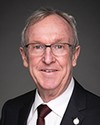I'm getting there.
In 2015 and 2016, the community said that they were still seeing issues and there were still concerns. Together with the Province of Ontario, we funded the community health assessment being undertaken by Dr. Donna Mergler, which Keith Conn spoke about earlier today, to investigate what is going on in the community to get a better understanding of the concerns. We're seeing, what we understand to be, both direct and indirect impacts of mercury poisoning.
In regard to the latter, for example, we spoke earlier about the socio-economic impacts. When a fishing guide is no longer able to fish, he can no longer feed his family. It's a struggle, and that has an impact on the social structure of the family. Those are the indirect impacts we are seeing.





